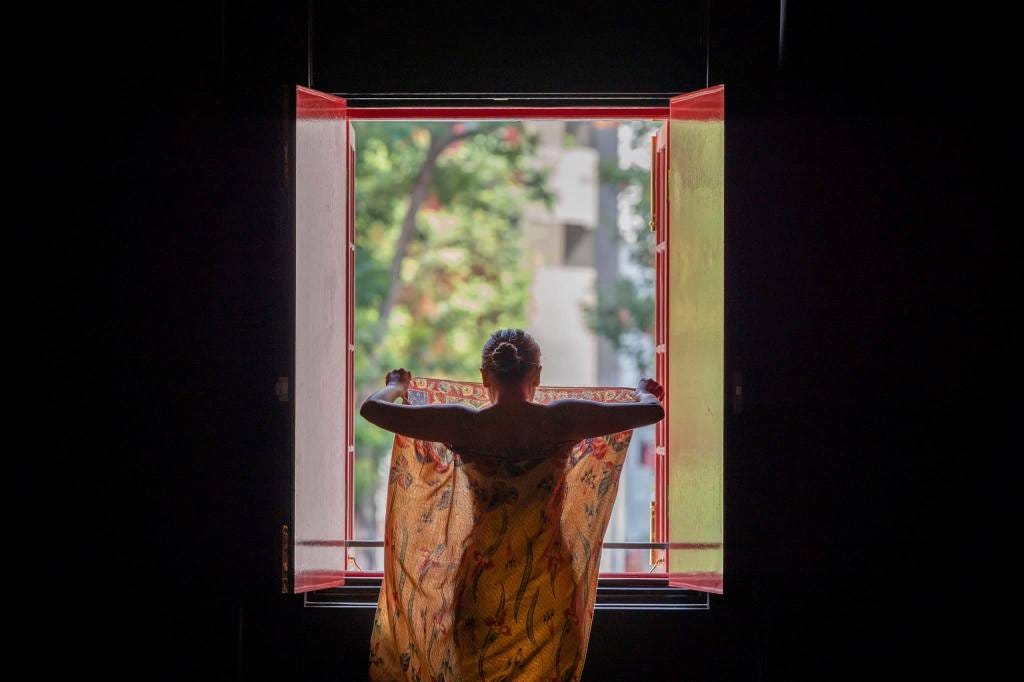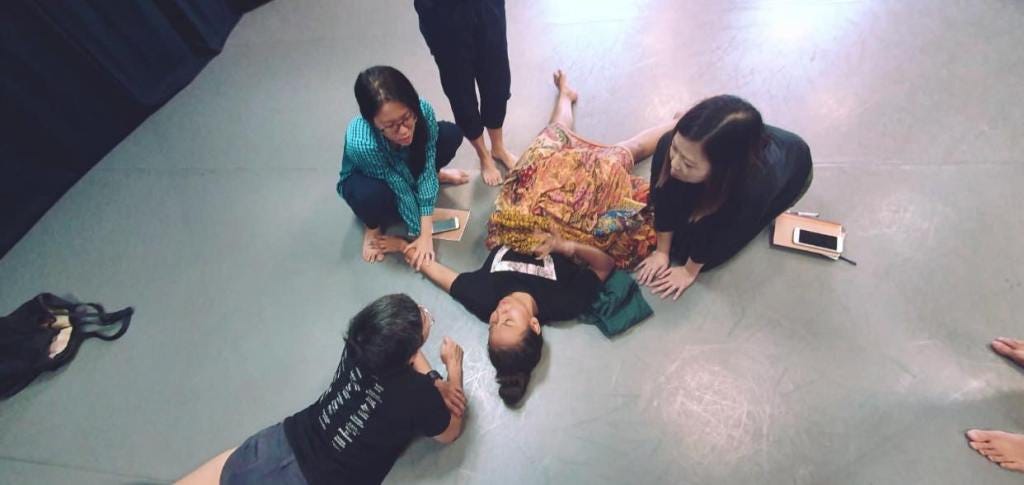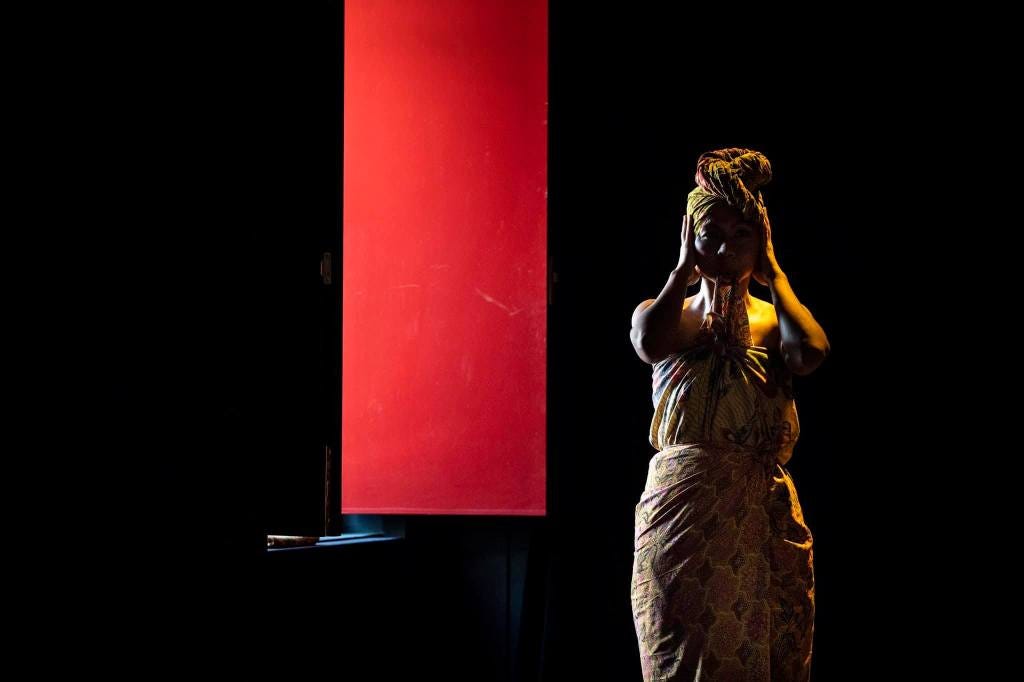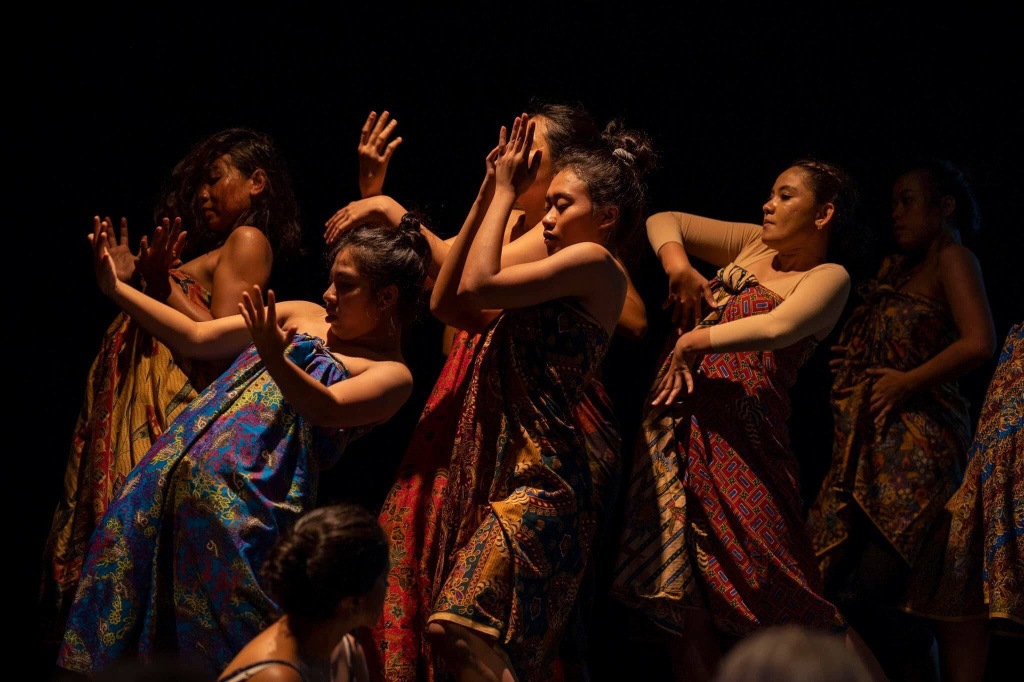Hasyimah Harith at the Stamford Arts Centre black box. Photo by Grace Baey.
An overdue and very informal post on this absolute blessing of a performance earlier in January – Nak Dara (“wanting a virgin”), a long-term performance project that P7:1SMA company manager Hasyimah Harith has been developing and ruminating over for several years. I’d witnessed an iteration of Nak Dara (there have been several!) at a SCOPE sharing session last year done solo, where Syimah stalked through the Dance Nucleus studio, swaddling herself in and then shedding the batik cloths knotted around her torso and waist and head – forcing us to pay attention to the resolve in her gaze, the come-hither narrowing of her eyes, the coy arch of her foot, the flash of a perfectly painted pink toenail. The slick of sweat on the ground, slowly evaporating, where she had quivered and shivered, the batik sliding almost dangerously up over her knees and thighs. She declared to all of us later, as we held her hands and mopped the sweat from her forehead and back: “Doing a solo is too hard!!! I need my collaborators!!!”
Bernice Lee, Sze Chan and I gathering around Hasyimah Harith at Dance Nucleus’ SCOPE. Photo by P7:1SMA.
This time, in the dark sticky heat of the Stamford Arts Centre black box, Syimah presses a balled up batik cloth into my open hands and lap. It is warm with sweat. It feels like both a gift and a curse, what brown women have to bear, to carry on their shoulders and around their hips. And here we are, members of a diverse audience granted temporary care of these creased pieces of cloth that could be a metaphor for Malay femininity; or a pointed question about Arabization, “modesty” and what it means to be “devout” and why this is associated with what we veil and what we reveal; or a celebration of female collectivism and self-soothing, the way you’d berkemban (knot the batik acorss the chest) when you go to a communal bathing area; and also an embrace of batik styles from across the Nusantara, whether Surakartan or Yogyakartan or Balinese...
I find myself weeping when Syimah salams me later, silently pressing her sweat-soaked forehead into my palms. I don’t know why I am crying. Is she asking me for forgiveness? But why do I feel like we’re the ones who have done her wrong? I want to tell her maaf, maaf, I’m not worthy of this gesture of respect or seniority. At the same time, before I return the batik into her arms, I want to press my face into it, devour it somehow, and it’s an impulse that feels pre-verbal... Am I feeling the kind of nafsu that Syimah longs to both activate and interrogate? That lust, that insatiable appetite, that itch we can’t scratch, that kind of gluttonous desire that I associate with food and immediately apprehend myself for doing so after: why do we think of consuming women’s bodies the way we do food (my own femme body; Syimah’s body; specifically brown bodies)... the way I think about moisture condensing on the taut rind of a peach or, as my fellow audience member Chloe put it... the moment you crack into the spongy flesh of a pomelo?
It’s this kind of unnerving self-critique the work subjects you to, that you want to revel in these libidinal, heaving, muscly, fleshy bodies as the floor thrums and aches beneath their feet – upturning everything I’ve taken for granted about Eurocentric notions of the various waves of feminism and Laura Mulvey’s theorizing of the male gaze, and whose pleasure women perform for. What if these don’t apply here; what if we need a new kind of decolonial female gaze? We’ve borrowed a lot and owe a great deal to black feminist theory and notions of the erotic as power by Audre Lorde. But I’m also thinking about specific, local practices — the physical and emotional vocabulary that dance practitioner Bernice Lee is documenting with #ghosting, as well as the careful narrative inventories of the Red Thread project by artists ila and Sonia Kwek (who’s also part of Nak Dara!), and the kinds of textured bodily interventions that mediate the encounter between different kinds of bodies in Southeast Asia. This might be the labours and sexualisation of brown bodies in particular, or colonised Asian bodies in a broader context. There’s such a thin line between recognising difference and fetishising it, and it’s a line I walk tentatively myself as a cishet Chinese Singaporean.
Hasyimah Harith in Nak Dara. Photo by Grace Baey.
At the same time I don’t deny the deliberate invitations for us to pleasure in, relish the sticky sweet tang of Nak Dara. How do we transform fetish into fellowship? This question takes over most of the second half of the work, when Syimah is finally joined by other performer-collaborators who had been sitting among us before (the night I attended: Sonia Kwek, Syimah Sabtu, Bib Mockram, Amira Azlin, Eya Awal Din, Pamela Tan, Atikah Hasimen). Researcher Nurul Fadiah Johari also brings up the possibility of a new kind of community in her programme notes to Nak Dara, “a way [of] forming ikatan, or the ties that bind women to each other through acts of imitasi - of following and fellowship.” Hasyimah does this by having her collaborators each go on their own journeys while paying attention to the trajectories of others. A couple of solos (specifically Sonia’s and Syimah Sabtu’s I think) involve rituals of bathing (mandi bunga! in the glistening evening air!) and ablutions – tender encounters with the bodies of other women in the room with water as kind of a gentle intermediary. We also get the shimmering, vibrating presence of percussionist and musician Syarfa Shahiran establishing the rhythmic backbone of the work but also responding to the women around her. Eya’s entire body unfurls to the music in front of me, the curve of her spine stretching and stacking. The women begin to return to each other, toying with each other’s batik and shrieking with laughter as they fight to pick at the fragile knots that keep the cloth around their bodies. I think of the bra-strap-snapping surprises that we’d spring on each other as teenagers in secondary school, or the first time I tried to knot a Burmese htamein around my waist, struggling to keep it taut (my Burmese in-laws eventually gave up and sewed a zipper in). What binds us together, what keeps up appearances, what “protects our modesty”, what threatens to fall apart...
It’s interesting to me that a male spectator later used the word “sorority” when he described his experience of the work to me; the choice of word stung, but I was also curious about examining my instinctive hurt. It reminds me of discussions around women-only spaces and how they’re critiqued for their supposed exclusionary quality – to me, at least, Nak Dara seemed to be modelling a utopic vision of unbridled sensuality and sexuality that, at this point in time, can only be summoned through a collective female energy. How can women, through a shared physical and movement vocabulary, establish the bounds of both safety and thrilling transgression for everyone in the room? As the women of Nak Dara tumble around us, or offer us tenderness, the tenderest parts of themselves – they also perform small acts of attentiveness and maintenance. You could also read this as acts of service – audience members received these acts with pleasure, allowing their hands to be touched, their feet to be washed. But I wondered if there was any room for us to reciprocate these acts, if this shared physical vocabulary could be the foundation for a broader and mutual aesthetics of care. Perhaps the batik that Hasyimah bestows upon us – and then returns to collect – are a reminder of who’s allowed to demonstrate temporary labour and then return the burden... and who continues to shoulder the weight long after the performative appearance of labour ends and the real work begins...
Nak Dara ran from January 10-12 at the Stamford Arts Centre Black Box. See the programme notes and a full list of practitioners and collaborators here.
p.s. In an earlier version of this post, I mistakenly used "berkemban" as a noun when really it's an act of knotting the batik over the chest – Hasyimah notes the state of the batik on the body and how the batik cloth becomes something else / transforms upon the self.
Photo by Grace Baey






